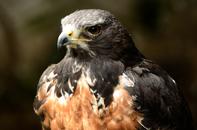
Name
The Jackal Buzzard (Buteo rufofuscus)Appearance
A jackal buzzard female is larger than the male. They are a very distinctive bird with a normal thick set buzzard stance. They have blackish underparts, rufous breast and mottled dark grey and white underparts. The tail is rufous. This buzzard has a black bill with a yellow cere. The eyes are a dark red-brown. It has yellow feet and legs.The Jackal Buzzard Diet
The jackal buzzard feeds mainly on smaller mammals up to the size of a hare. It will also feed on birds, frogs, reptiles and insects. During the winter months, it will scavenge at carcasses and road kill.The Jackal Buzzard Breeding
During the breeding season, between May and November, the jackal buzzard is monogamous. Both sexes take part in building a nest out of sticks and line it with grass and leaves. The female lays 2 eggs, which are incubated by the female, who is fed by the male during this period.
The chicks practise silicide (the older or bigger chick will kick the smaller chick out of the nest or kill it). The young are fed by the female with food brought to the nest by the male. The chick fledges at around 50 days.